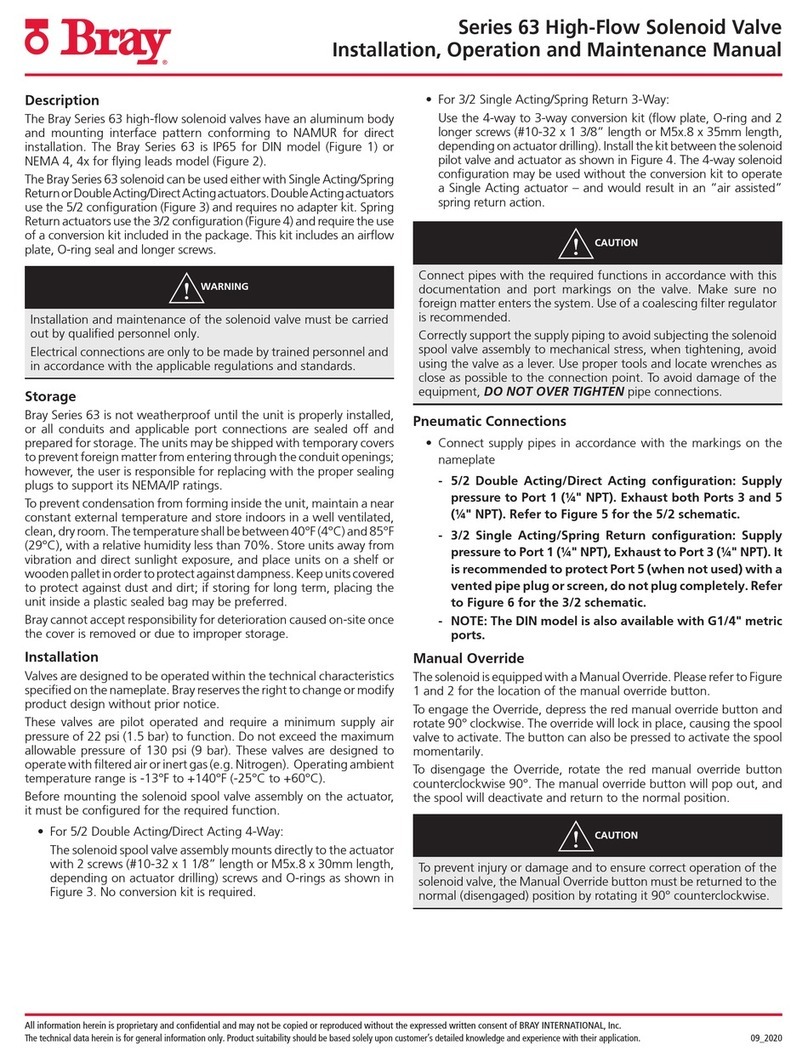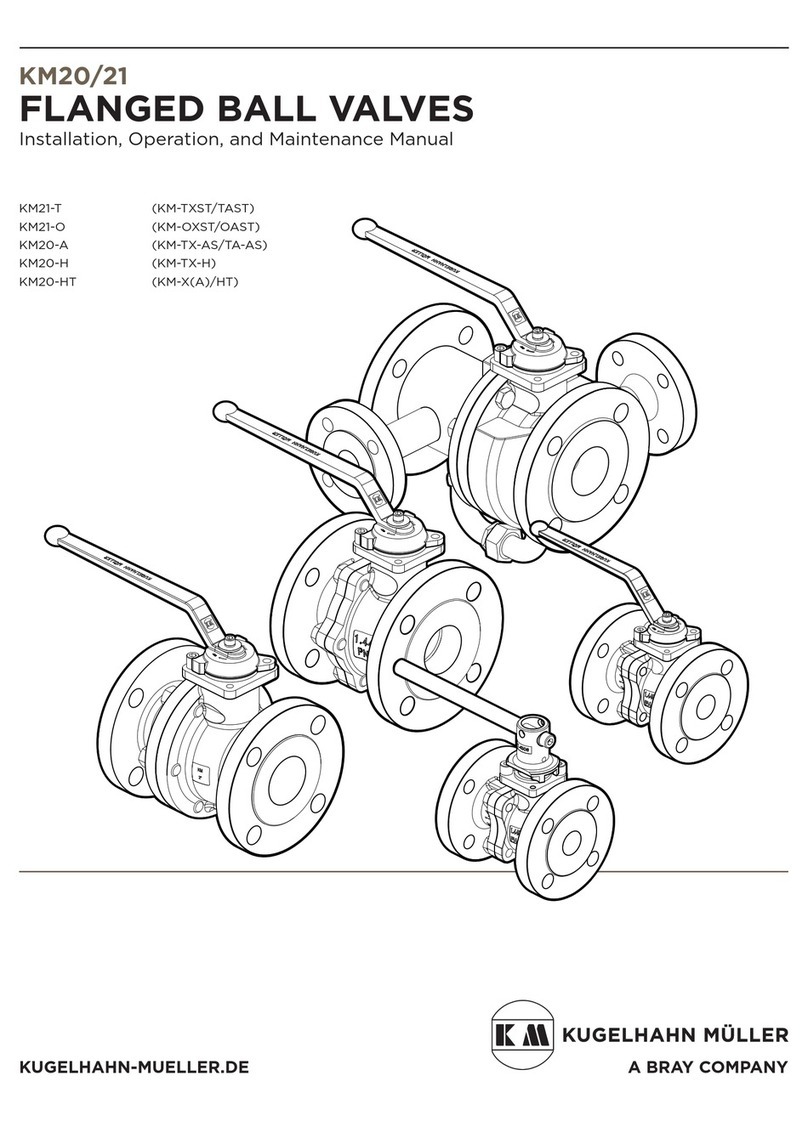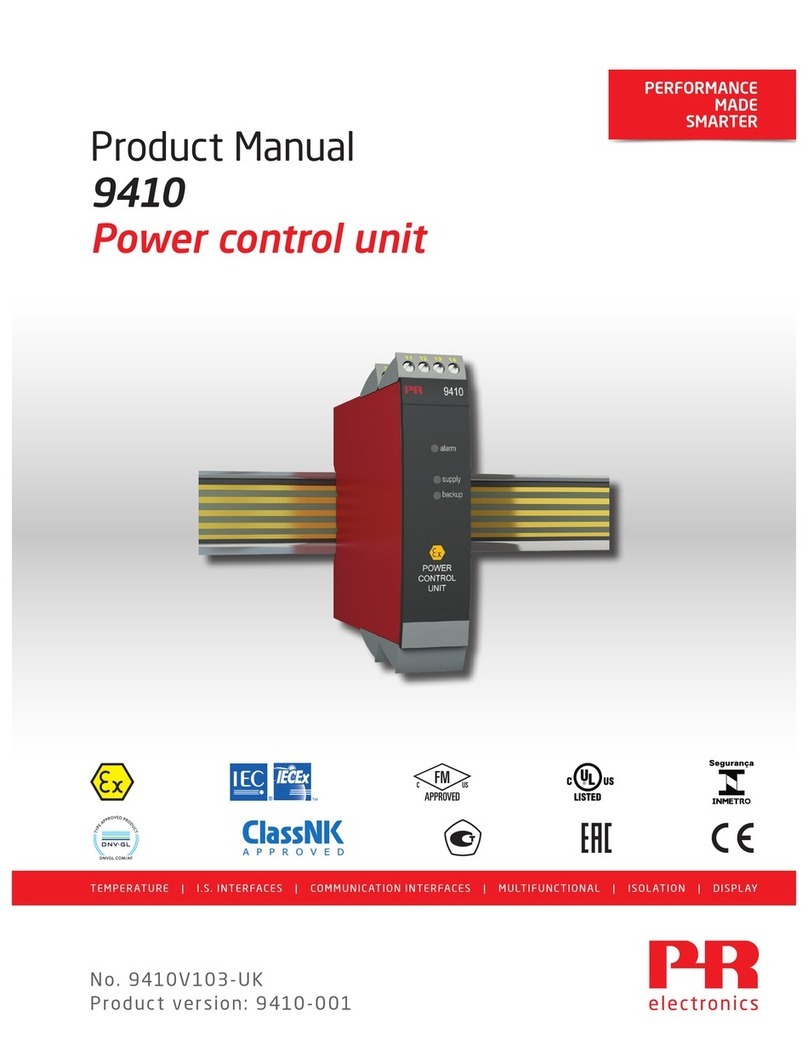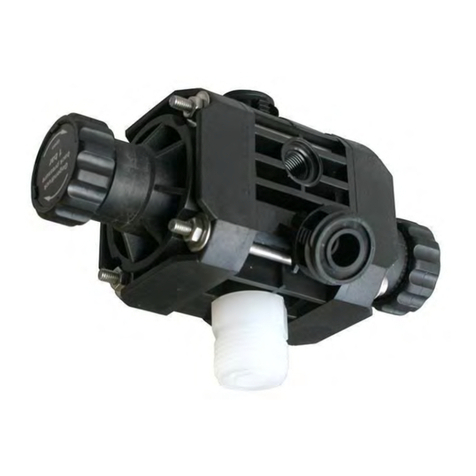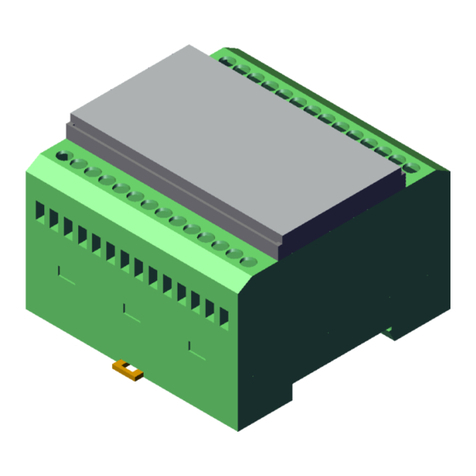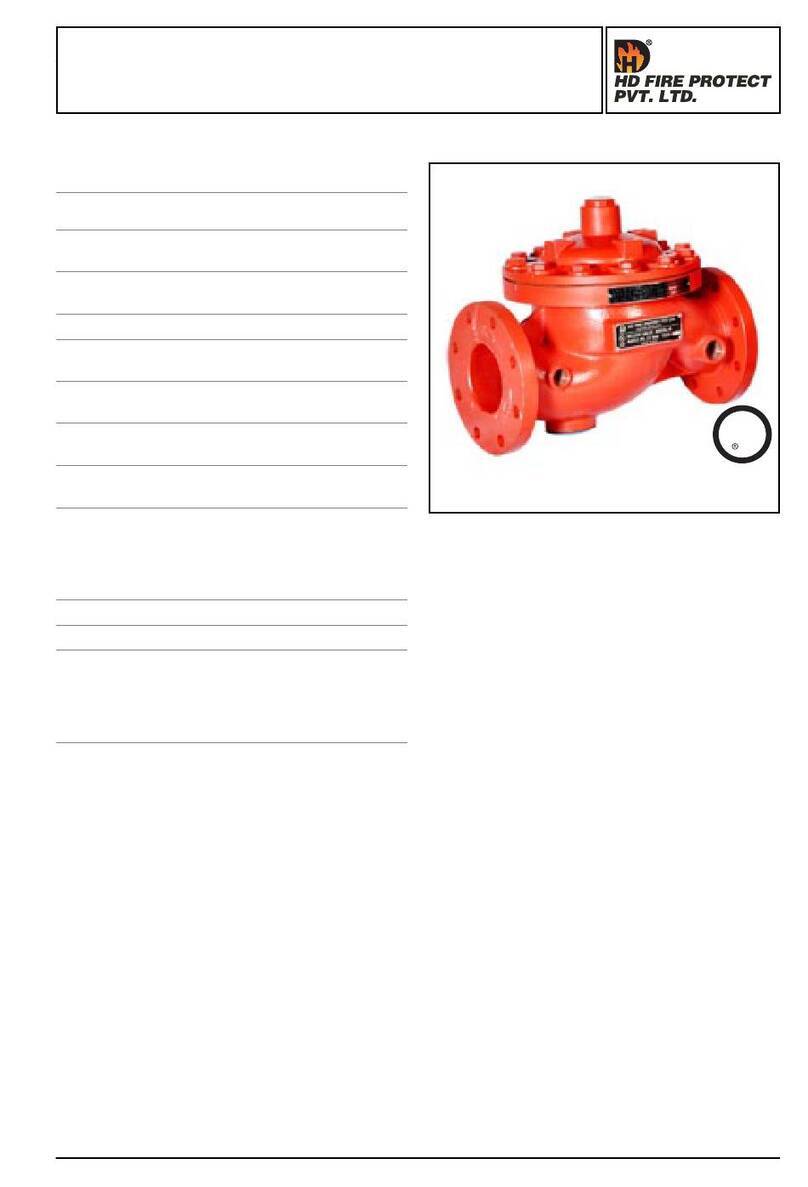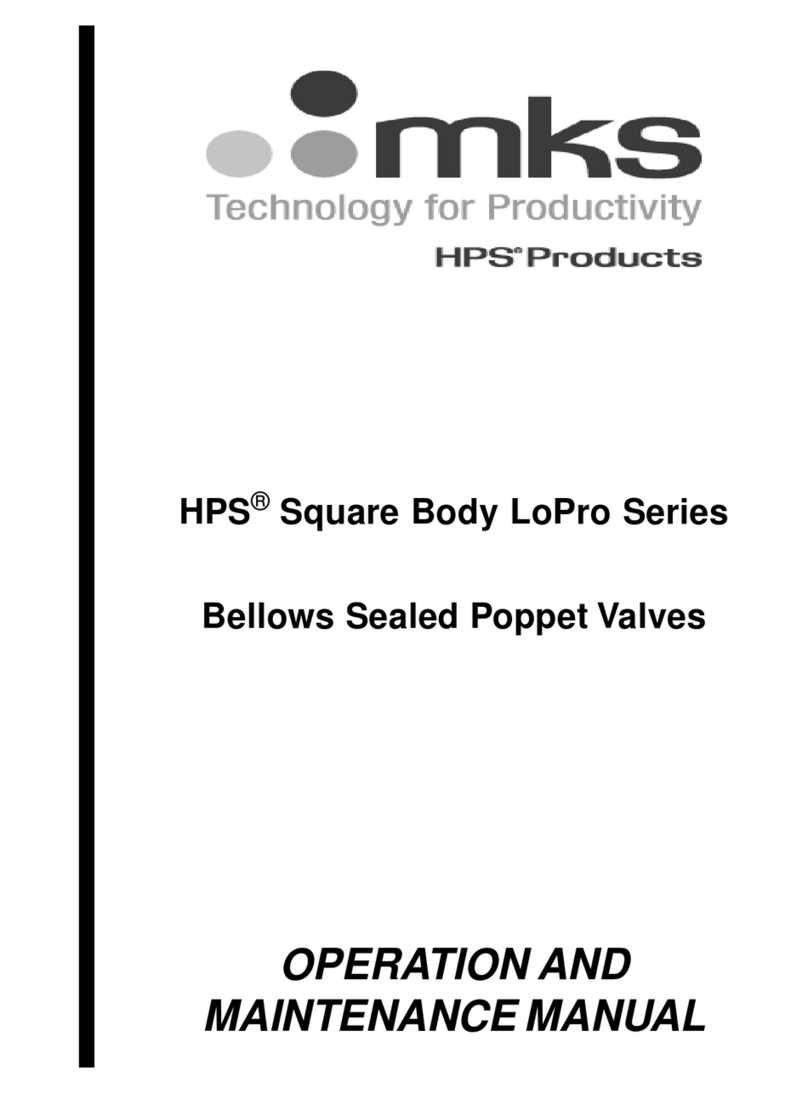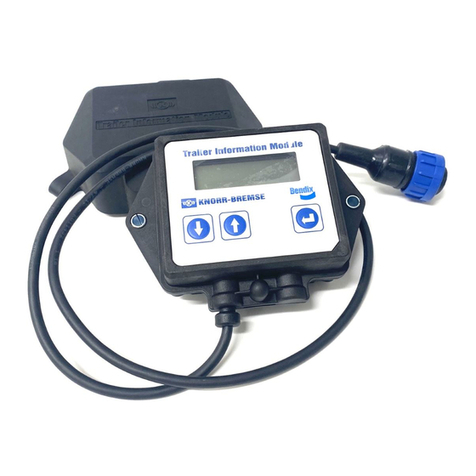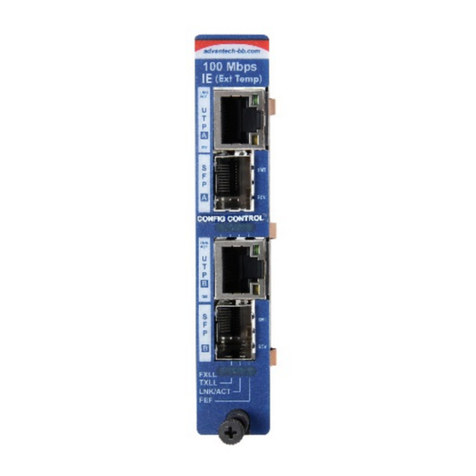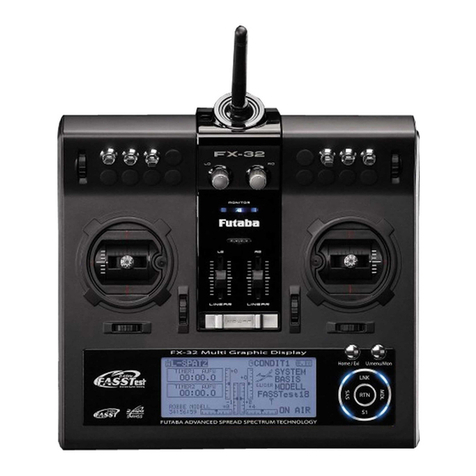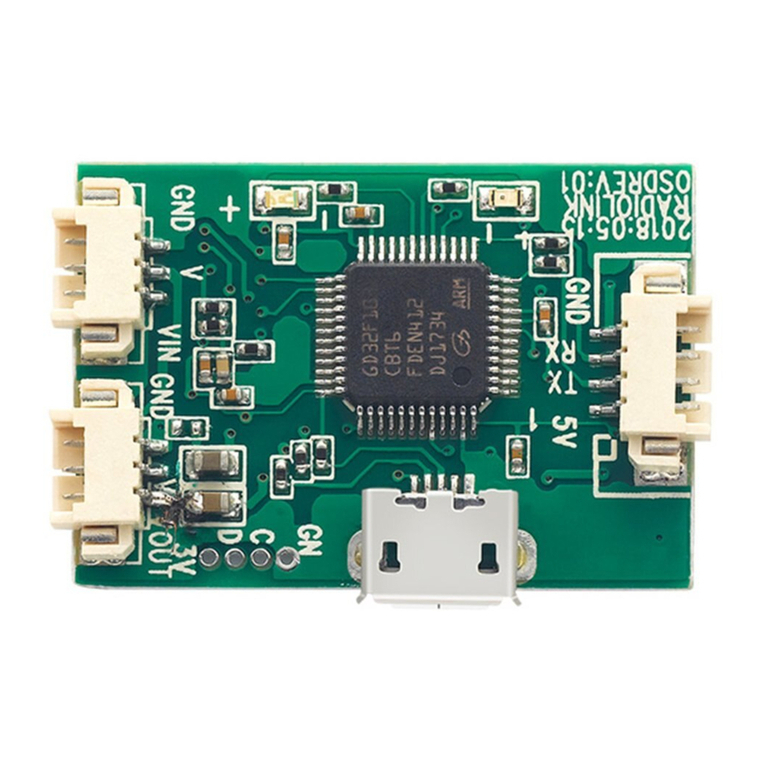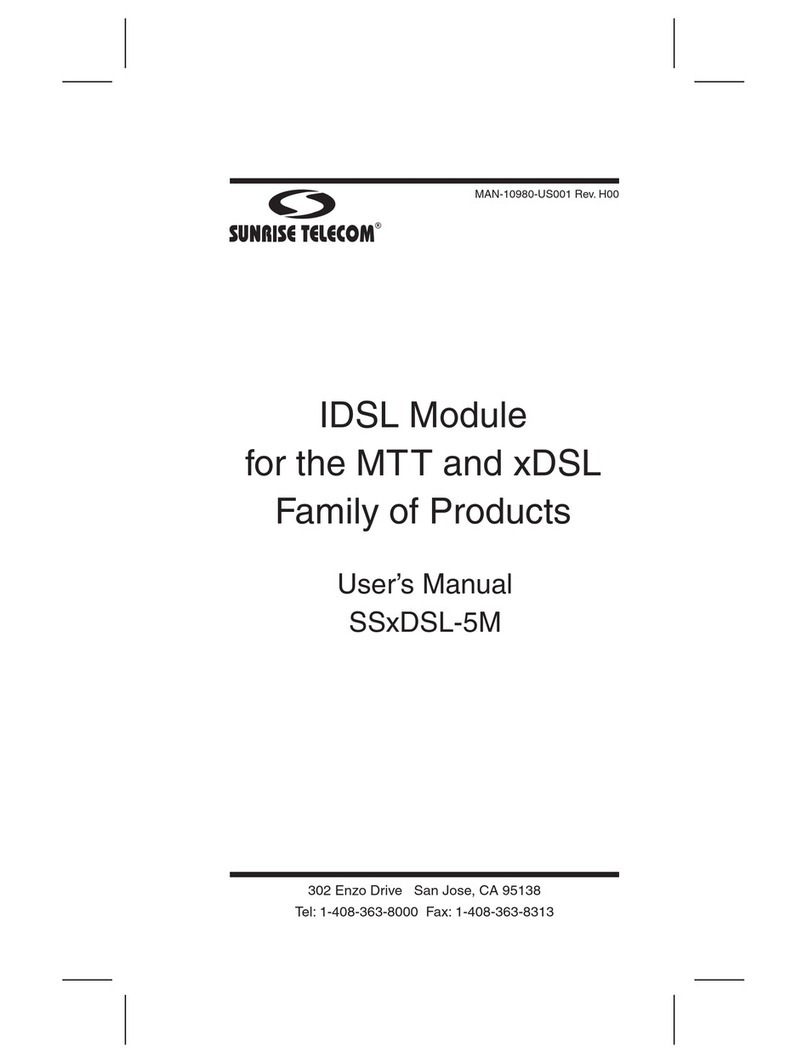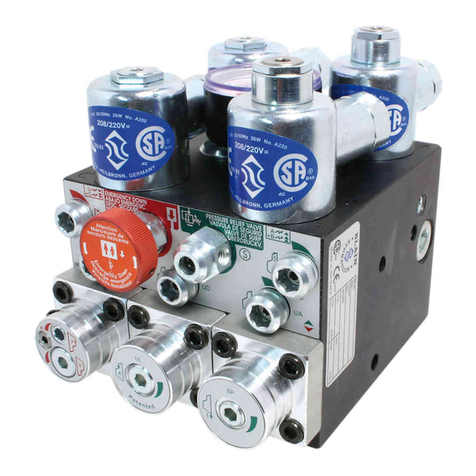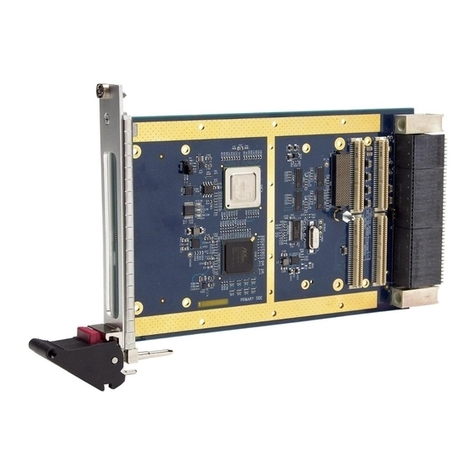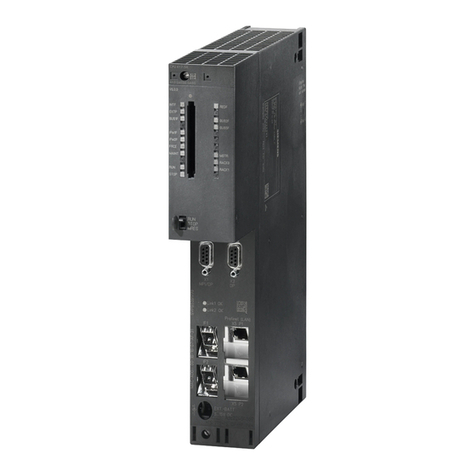Bray MCCANNALOK User manual

BRAY/MCCANNALOK EN
High Performance Butterfly Valve
Operation and Maintenance Manual
YOUR GLOBAL FLOW CONTROL PARTNER™

Bray/McCannalok EN
Operation and Maintenance Manual
1
The Information contained herein shall not be copied, transferred, conveyed, or displayed in any manner that would violate its
proprietary nature without the express written permission of Bray International, Inc.
For information on this product and other Bray products please visit us on our website ·www.bray.com
TABLE OF CONTENTS
1.0 Definition of Terms . . . . . . . . . . . . . . . . . . . . . . . . . . . . . . . . . . . . . . . 2
2.0 Introduction. . . . . . . . . . . . . . . . . . . . . . . . . . . . . . . . . . . . . . . . . . . 2
3.0 Valve Indentification . . . . . . . . . . . . . . . . . . . . . . . . . . . . . . . . . . . . . . 3
4.0 Installation . . . . . . . . . . . . . . . . . . . . . . . . . . . . . . . . . . . . . . . . . . . 4
5.0 Maintenance . . . . . . . . . . . . . . . . . . . . . . . . . . . . . . . . . . . . . . . . . . 5
6.0 Stem seal replacement . . . . . . . . . . . . . . . . . . . . . . . . . . . . . . . . . . . . 6
7.0 Seat replacement. . . . . . . . . . . . . . . . . . . . . . . . . . . . . . . . . . . . . . . . 7
8.0 Disc and Stem replacement . . . . . . . . . . . . . . . . . . . . . . . . . . . . . . . . . . 8
9.0 Field adjustments . . . . . . . . . . . . . . . . . . . . . . . . . . . . . . . . . . . . . . 10
10.0 Figures . . . . . . . . . . . . . . . . . . . . . . . . . . . . . . . . . . . . . . . . . . . . . 11

Bray/McCannalok EN
Operation and Maintenance Manual
2
The Information contained herein shall not be copied, transferred, conveyed, or displayed in any manner that would violate its
proprietary nature without the express written permission of Bray International, Inc.
1.0 DEFINITION OF TERMS
indicates a potentially hazardous situation which, if not avoided,
could result in death or serious injury.
indicates a potentially hazardous situation which, if not avoided,
may result in minor or moderate injury.
NOTICE
Used without the safety alert symbol indicates a potential situation which,
if not avoided, may result in an undesirable result or state, including
property damage.
READ AND FOLLOW THESE INSTRUCTIONS
SAVE THESE INSTRUCTIONS
2.0 INTRODUCTION
2.1 The Bray/McCannalok EN high performance
butterfly valve combines the advantages
of trunnion-type ball valves with the easy
operation, light weight, and low cost of butterfly
valves. One basic design is suitable for a wide
range of services, including oxygen, chlorine,
sour gas, vacuum, and steam applications.
2.2 FEATURES INCLUDE:
2.2.1 Bubble tight shutoff provided throughout a
wide range of operating conditions.
2.2.2 Suitable for both modulating and on/off
services, the Bray/McCannalok EN butterfly
valve is easily automated with your choice
of manual operators, electric and pneumatic
actuators, positioners, and controls.
2.2.3 External travel stop for preventing over-
travel of disc in opening and closing.
2.2.4 Uninterrupted gasket sealing faces.
2.2.5 Extended neck body for providing pipe
insulation clearance of 60mm.
2.2.6 Blind bottom body design up to DN 300.
2.2.7 Bearing seal for protecting bearings from
particle ingress.
2.3 Additional information about Bray/McCannalok
EN butterfly valves – including application
data, engineering specifications, and actuator
selection is available from your Bray distributor
or sales representative.

Bray/McCannalok EN
Operation and Maintenance Manual
3
The Information contained herein shall not be copied, transferred, conveyed, or displayed in any manner that would violate its
proprietary nature without the express written permission of Bray International, Inc.
3.0 VALVE IDENTIFICATION
3.1 All Bray/McCannalok EN valves are provided
with an identification tag with the following data
printed on it:
>P/N: Full part number of the valve assembly
>S/N: Unique serial number of valve
>TAG: Valve or instrument tag number
provided by customer
>DN: Valve size e.g. DN 150
>PN: Pressure rating of mating flange
>TS: Maximum permissible temperature in
degree Celsius (°C)
>PS: Maximum permissible pressure in bar(g)
at room temperature
>BODY: Material grade of body/seat
retainer e.g. 1.4408, 1.0619 etc.
>DISC: Material grade of disc e.g. 1.4408
>STEM: Material grade of stem e.g. 1.4542
>SEAT: Material of seat e.g. R-PTFE
>SEAL: Material of stem seal e.g. PTFE
>YEAR MFD: Month and year of
manufacture MM/YY
3.2 The valves are also provided with a tag plate on
the actuator mounting flange with the following data
printed on it:
>F<XX>: Actuator mounting flange size as
per ISO 5211 e.g. F07
><Y>: Breakaway torque in Nm at a
differential pressure of 3.5 bar (air or
nitrogen)
><Z>: Maximum allowable stem torque in Nm
F 07 / 60 – 300 Nm
F <XX> / <Y> – <Z> Nm

Bray/McCannalok EN
Operation and Maintenance Manual
4
The Information contained herein shall not be copied, transferred, conveyed, or displayed in any manner that would violate its
proprietary nature without the express written permission of Bray International, Inc.
4.0 INSTALLATION
4.1 The Bray/McCannalok EN valve is designed
to be mounted between EN, DIN and JIS flanges.
When the valve is open, the disc will extend into
the pipe on both sides of the valve – further
on the body side than the seat retainer side of
the valve. Piping must be large enough to allow
the disc to clear the pipe. Table 1 shows the
minimum pipe ID allowable.
Table 1: MINIMUM INSIDE DIAMETER OF PIPE
WITH THE RECOMMENDED CLEARANCE
Valve
Size
Minimum Pipe ID (mm)
PN 10 PN 16 PN 25 PN 40
DN 65 60.0 60.0 60.0 60.0
DN 80 74.5 74.5 74.5 74.5
DN 100 96.0 96.0 96.0 96.0
DN 125 124.5 124.5 124.5 124.5
DN 150 152.5 152.5 147. 5 147.5
DN 200 203.0 203.0 196.5 196.5
DN 250 253.5 253.5 244.0 244.0
DN 300 303.5 303.5 290.5 290.5
DN 350 333.0 333.0 333.0 333.0
DN 400 376.5 376.5 376.5 376.5
If handle or actuator has been removed do not
rotate disc beyond full open or closed position
– this could cause damage to sealing surfaces.
NOTE: Bray/McCannalok EN valves are equipped with
external travel stops to prevent disc over-travel. The valve
is opened by turning counter clockwise, closed by turning
clockwise. The double “D” flats or keyway at the top of the
stem is parallel to the disc edge.
NOTICE
For maximum service life, install the valve with
the seat retainer upstream. Positive shutoff will
be obtained with the valve in either position;
however, installation with the seat retainer
upstream will give longer service life, especially
in erosive services.
4.2 With the disc in closed position, carefully
center valve between flanges. Guide holes
(wafer-type valve) or tapped holes (lug-type
valves) to match pipe flanges and assist in
positive alignment.
4.3 Flange gaskets are not generally included
in the scope of supply of Bray/McCannalok
EN valves. Flange gaskets should conform to
EN1514-1 flat seal with form IBC or form FF.
4.4 The standard lug-type valve can be used in
end of line service (downstream dismantling)
only in one direction. The seat retainer side of
the valve should be mounted upstream.
UPSTREAM
FLOW

Bray/McCannalok EN
Operation and Maintenance Manual
5
The Information contained herein shall not be copied, transferred, conveyed, or displayed in any manner that would violate its
proprietary nature without the express written permission of Bray International, Inc.
5.0 MAINTENANCE
5.1 Reasonable precautions should be taken
before beginning work on the valve. Protective
clothing, as required by the specific line fluid,
should be worn.
Before removing handle or the actuator from
the valve, or before removing seat retainer from
a valve in dead end service, close the valve and
depressurise the line.
5.2 The eccentric design of the Bray/
McCannalok EN may allow line pressure to open
the valve if the handle/actuator is not in place
while the valve is under pressure.
Do not pressurise the line without an operator
mounted on the valve.
5.3 The Bray/McCannalok EN valve must be in
the closed position to be removed from the line.
5.4 External travel stop is not for disc
positioning. Travel stop prevents over-travel
of disc in opening and closing. If the disc
movement is restricted by the travel stop, the
disc has overtravelled..
The stem is coupled to the external travel stop
by which the disc over travel is prevented.
The external travel stop may hit or come very
close to the top plate surfaces at the end of
open and closed positions. The impact of this
force can be quite high depending on the
actuator speed of operation. Keep hand or
fingers away from the travel stop while the
valve is in operation.
5.5 Begin all work on a valve that has been
removed from the line by cleaning the valve,
removing any grit or scale.
When handling the valve, care should be taken
not to scratch the disc edge or seat.
5.6 Replacement seats, seals and other parts are
available from authorised distributors. Contact
your distributor or sales representative for
details of price and delivery.
5.7 When using a pipe whose ID is smaller than
the recommended minimum inside diameter of
pipe with adequate clearance, a chamfer of 45°
should be provided on the end of the pipe so
that it clears the disc.

Bray/McCannalok EN
Operation and Maintenance Manual
6
The Information contained herein shall not be copied, transferred, conveyed, or displayed in any manner that would violate its
proprietary nature without the express written permission of Bray International, Inc.
6.0 STEM SEAL REPLACEMENT
NOTICE
Note assembly positions before removal.
6.1 Refer Figure 1 (p.11) and Figure 2 (p.12) for
parts identification.
6.2 If required, remove operator.
Remove TOP PLATE SCREWS (220).
Remove TOP PLATE (210).
6.3 Remove TRAVEL STOP SCREW (240) and
TRAVEL STOP (230).
6.4 Remove KEY (250) if applicable.
6.5 Remove GLAND NUTS (170) and LOCK
WASHERS (180).
Remove GLAND RETAINER (140), RETAINING
RING (150) and GLAND RING (130).
NOTE: For valve sizes DN 350 through DN 400, remove
the DISC SPRINGS (260) along with GLAND RING (130)
6.6 Hook out STEM SEALS (120). Do not remove
WASHER (110), unless further valve disassembly
is required.
During removal of the stem seals, care should
be taken not to scratch stem or stuffing box
bore.
6.7 Examine stuffing box bore and stem, clean
as necessary to remove any corrosion or foreign
matter before installing new seals.
6.8 Install new seals in stuffing box one at a
time, TFE (white) seals first, with the carbon
fiber ring at the top if applicable.
Stagger seal ring joints 180° apart when
installing. Tap each ring to bottom and compress
the ring before installing next ring. Refer Table 2
for total quantity of seal rings in each valve.
Table 2: TOTAL NUMBER OF STEM SEALS
Valve Size PN 10 PN 16 PN 25 PN 40
DN 65 4444
DN 80 4444
DN 100 4444
DN 125 4444
DN 150 4444
DN 200 5555
DN 250 5555
DN 300 5555
DN 350 6666
DN 400 6666
6.9 Slide GLAND RING (130) over STEM (22) on
top of STEM SEALS (120).
Install RETAINING RING (150).
Slide GLAND RETAINER (140) over stem and
onto GLAND STUDS (160).
Place LOCK WASHERS (180) and GLAND NUTS
(170) on GLAND STUDS (160) and tighten finger
tight. Tighten GLAND NUTS (170) evenly and
alternately to the proper torque value given in
Table 3.
Table 3: GLAND NUT TIGHTENING TORQUES
Tightening Torque (N-m)
Valve
Size
Series
4D/4E
Series
4F/4G
Series
4H/4J
Series
4K/4L
PN 10 PN 16 PN 25 PN 40
DN 65 7 7 7 7
DN 80 7 7 7 7
DN 100 7 7 7 7
DN 125 9 9 9 9
DN 150 9 9 11 11
DN 200 10 10 15 15
DN 250 16 16 18 18
DN 300 18 18 23 23
DN 350 29 29 29 29
DN 400 49 49 49 49

Bray/McCannalok EN
Operation and Maintenance Manual
7
The Information contained herein shall not be copied, transferred, conveyed, or displayed in any manner that would violate its
proprietary nature without the express written permission of Bray International, Inc.
6.10 Install KEY (250) on STEM (22) if applicable.
6.11 Slide TRAVEL STOP (230) over STEM (22)
and tighten TRAVEL STOP SCREW (240).
6.12 Install TOP PLATE (210) while ensuring the
TRAVEL STOP (230) orientation is correct.
6.13 Tighten the TOP PLATE SCREWS (220) to
torque value given in Table 4.
6.14 Remount operator.
6.15 Operate valve open and close several times
to check for binding and to set the stem seals.
Loosen GLAND NUTS (170) and then proceed to
retighten to the torque valves stated in Table 3.
7.0 SEAT REPLACEMENT
Before removing handle or the actuator from
the valve, or before removing seat retainer from
a valve in dead end service, close the valve and
depressurise the line.
Do not pressurise the line without an operator
mounted on the valve.
7.1 Refer Figure 1 (p.11) and Figure 2 (p.12) for
parts identification.
7.2 With the DISC (21) in the closed position,
remove the valve from the line.
7.3 Lay the valve down with the DISC (21) in the
closed position and the seat retainer side facing up.
7.4 Remove the RETAINER PLATE SCREWS
(60), RETAINER PLATES (50), SEAT RETAINER
(40), and SEAT (30).
7.5 Carefully clean the seat area in the BODY
(10) and SEAT RETAINER (40).
Remove foreign material, dirt, etc. Check disc
seating area for nicks or scratches.
7.6 With the DISC (21) is in the CLOSED position,
place the new SEAT (30) on DISC (21), carefully
centering it in the recess in the BODY (10).
7.7 Carefully place the SEAT RETAINER (40) in
position on top of SEAT (30).
7.8 Slide in the RETAINER PLATES (50) into the
groove on the SEAT RETAINER (40) and align
the countersunk holes to the tapped holes on
the BODY (10).
7.9 Lightly grease the threads and install the
RETAINER PLATE SCREWS (60).
Table 4: TOP PLATE SCREW TIGHTENING TORQUE
Tightening Torque (Nm)
Valve
Size
Series
4D/4E
Series
4F/4G
Series
4H/4J
Series
4K/4L
PN 10 PN 16 PN 25 PN 40
Screw Torque Screw Torque Screw Torque Screw Torque
DN 65 M8 15 M8 15 M8 15 M8 15
DN 80 M8 15 M8 15 M8 15 M8 15
DN 100 M8 15 M8 15 M8 15 M8 15
DN 125 M8 15 M8 15 M10 30 M10 30
DN 150 M8 15 M8 15 M10 30 M10 30
DN 200 M10 30 M10 30 M12 50 M12 50
DN 250 M12 50 M12 50 M12 50 M12 50
DN 300 M12 50 M12 50 M20 245 M20 245
DN 350 M20 245 M20 245 M20 245 M20 245
DN 400 M20 245 M20 245 M20 245 M20 245

Bray/McCannalok EN
Operation and Maintenance Manual
8
The Information contained herein shall not be copied, transferred, conveyed, or displayed in any manner that would violate its
proprietary nature without the express written permission of Bray International, Inc.
8.0 DISC AND STEM REPLACEMENT
Before removing handle or the actuator from
the valve, or before removing seat retainer from
a valve in dead end service, close the valve and
depressurise the line.
Do not pressurise the line without an operator
mounted on the valve.
8.1 Refer Figure 1 (p.11) and Figure 2 (p.12) for
parts identification.
NOTICE
Stem and disc are supplied as a matched set
with taper pins and are to be replaced as a set.
8.2 Remove handle assembly/gear box/actuator.
Remove TOP PLATE SCREWS (220).
Remove TOP PLATE (210).
8.3 Remove TRAVEL STOP SCREW (240) and
TRAVEL STOP (230).
8.4 Remove KEY (250) if applicable.
NOTICE
Note assembly positions before removal.
8.5 Remove GLAND NUTS (170) and LOCK
WASHERS (180). Remove GLAND RETAINER
(140), RETAINING RING (150) and GLAND RING
(130).
NOTE: For valve sizes DN 350 through DN 400, remove
the DISC SPRINGS (260) along with GLAND RING (130)
8.6 Hook out STEM SEALS (120).
When removing stem seals, care should be
taken not to scratch stem or stuffing box bore.
8.7 Remove the RETAINER PLATE SCREWS
(60), RETAINER PLATES (50), SEAT RETAINER
(40), and SEAT (30).
8.8 Turn DISC (21) to the full open position and
drill out tack welds on large end of TAPER PINS
(23).
Drill sizes to remove tack welds are given in
Table 5.
Take care to support valve so that disc surfaces
are not scratched.
Table 5: DRILL SIZE TO REMOVE TACK WELD
Drill Size (mm)
Valve Series 4D/4E/4F/4G
PN 10/PN 16
Series 4H/4J/4K/4L
PN 25/PN 40
DN 65 4 4
DN 80 4 4
DN 100 4 4
DN 125 4.5 4.5
DN 150 4.5 5
DN 200 5.5 6.5
DN 250 6.5 8
DN 300 8.5 12.5
DN 350 12 12
DN 400 12 12
NOTE: Use center-punch to dimple center of tack welds
prior to drilling.
8.9 Place valve in flat position, with flat face
of disc up. Support disc and body on wooden
blocks to protect disc and body surfaces. Disc
will rest in partially open position.
8.10 Knock out TAPER PINS (23) using a rod or
punch on small end of pin (opposite tack weld).
It may be necessary to lift body and rotate disc
slightly to do this. Make sure disc is resting on
wood block since it will swing freely on stem
with pins removed. When TAPER PINS (23) are
removed, lay body down so disc and body are
evenly supported on flat surface.

Bray/McCannalok EN
Operation and Maintenance Manual
9
The Information contained herein shall not be copied, transferred, conveyed, or displayed in any manner that would violate its
proprietary nature without the express written permission of Bray International, Inc.
8.11 Valve sizes DN 65 to DN 300 has a blind
bottom body. So the STEM (22) needs to
be pulled out from the top side of the valve.
After long or severe service this may take
considerable force. Be careful not to damag e
bearings, spacers or body.
NOTE: To make stem disassembly easier, the GLAND
RETAINER (140) can be inserted in reverse direction over
the stem with the counter bore facing towards the top
face of the STEM (22) and placing the RETAINING RING
(150) or SPLIT RINGS between the stem and gland retainer.
The gland retainer can then be pulled outwards which will
transfer the force to the stem through the retaining ring.
8.12 For Valve sizes DN 350 to DN 400 perform
the following steps.
8.12.1 Remove the BOTTOM PLATE NUTS (320),
BOTTOM PLATE (300), WAVE SPRING (280),
DISC SUPPORT (270) and GASKET (290) from
the bottom side of BODY (10).
8.12.2 Using a brass bar or drift punch, knock
STEM (22) loose and pull from BODY (10).
After long or severe service this may take
considerable force.
Be careful not to damage bearings, spacers or
body.
8.13 DISC SPACERS (70) are used at top and
bottom of DISC (21) to properly position disc
in BODY (10). Proper spacers were selected at
initial assembly and rarely require replacement.
The location of these spacers should be noted,
and the spacers marked at disassembly so that
they are reinstalled in the same positions, top
and bottom.
8.14 Separate BODY (10) from DISC (21), and
remove WASHER (110) from packing bore.
8.15 Examine BEARINGS (80) for excessive wear.
If removed from body, note position and mark to
reinstall in same location. If bearing liner is worn
through to the shell, or severe damage is evident
they should be replaced. Replacement is rarely
needed.
8.16 Clean BODY (10) thoroughly to remove all
dirt, foreign matter, rust, etc.
8.17 Place the BODY (10) flat, seat retainer side
up, and support it on wooden blocks sufficiently
above the work surface as to facilitate insertion
of the DISC (21) in open position.
8.18 Install the DISC SPACERS (70) in to the body
stem bore making sure that spacers are returned
to original locations as marked in step 8.13
8.19 Lower the disc into position, aligning the
bores in BODY (10) and DISC (21).
8.20 Insert new STEM (22) in BODY (10) with
large end of the taper pin holes toward the top.
8.21 Align taper pin holes in disc and stem, and
install TAPER PINS (23). Drive pins in tightly with
rod or punch, and tack weld each pin to DISC
(21) at large end of pin.
8.22 For Valve sizes DN 350 to DN 400 perform
the following steps.
8.22.1 Install new GASKET (290) in to the groove
on the bottom face of BODY (10).
Valve sizes DN 200 through DN 300 has an M6 tapped hole on the top face of the stem which can
be used to attach an eye bolt to pull out the stem.

Bray/McCannalok EN
Operation and Maintenance Manual
10
The Information contained herein shall not be copied, transferred, conveyed, or displayed in any manner that would violate its
proprietary nature without the express written permission of Bray International, Inc.
8.22.2 Install DISC SUPPORT (270), WAVE
SPRING (280) and BOTTOM PLATE (300)
8.22.3 Tighten BOTTOM PLATE NUTS (320) to
torque mentioned in Table 6. Table 6: BOTTOM
PLATE TIGHTENING TORQUE
Tightening Torque (Nm)
Valve
Size
Series
4D/4E
Series
4F/4G
Series
4H/4J
Series
4K/4L
PN 10 PN 16 PN 25 PN 40
DN 350 11 11 11 11
DN 400 16 16 16 16
8.23 Install new STEM SEALS (120), following
instructions in section 6.0 STEM SEAL
REPLACEMENT
8.24 Install new SEAT (30), following
instructions in section 7.0 SEAT REPLACEMENT
8.25 Remount handle operator, and operate
valve several times to verify proper operation.
Examine disc and seat for any damage before
reinstalling in line.
9.0 FIELD ADJUSTMENTS
9.1 Stem Seal Leakage – Should leakage
occur at the stem seals, it may be stopped by
retightening the GLAND NUTS (170) to the
values specified in Table 3.
NOTE: If the leakage cannot be stopped by this action, the
stem seals require replacement.
NOTICE
Do not overtighten gland nuts, as this may
cause increased operating torque and improper
valve operation or closure.
9.2 Adjusting Valve Closure – Valves with gear
actuators or electric/pneumatic actuators may
require adjustment of the travel stops in the
actuator to properly close valve for tight shut-
off. The following procedure should be followed
to set travel or limit stops. (It is recommended
that the valve must be removed from line for this
procedure and actuator mounting).
9.2.1 Using a straight-edge and Vernier or depth
caliper, measure the distances from the face
of the SEAT RETAINER (40) to the DISC (21)
(valve closed) face at the 3 o’clock and 9 o’clock
positions (stem is at 12 o’clock position). The
measurements must agree within 1.5mm.
9.2.2 If they do not agree, DISC (21) must be
rotated in the direction of the larger dimension.
If the 3 o’clock dimension is larger, the disc is
not fully closed, and must be rotated in the
“close” direction more. If 9 o’clock dimension is
larger, disc is over-closed, and must be opened
slightly.
9.2.3 The valve DISC (21) is at the full open
position when the disc is perpendicular to the
BODY (10). Set the “open” actuator stop for this
position.
9.2.4 On gear operators, loosen and adjust
the closing stop screw to permit proper disc
positioning. Adjust and lock down when
disc closure is within measured tolerance
in Step 9.2.1. Open and close valve; recheck
measurements before reinstalling in line.
NOTICE
The setting of the actuation device’s close
travel stop is important. The valve has an
external travel stop to ensure valve disc cannot
be over closed or opened. To ensure that the
valve travel stop is not damaged, the actuator
close travel stop bolt must be at a position just
before valve disc contacts it’s travel limiter.
9.2.5 For other power actuators, consult the
manufacturer’s instructions for setting travel
stops, as these vary with actuator model and
type.
9.2.6 If removing the valve from the line is not
practical, as a crude remedy the disc can be
placed into a position in the seat at which the
leakage stops and travel stops are adjusted to
this position.

Bray/McCannalok EN
Operation and Maintenance Manual
11
The Information contained herein shall not be copied, transferred, conveyed, or displayed in any manner that would violate its
proprietary nature without the express written permission of Bray International, Inc.
10.0 FIGURES
Figure 1: DN 65 – DN 300
Item Qty. Description
10 1 Body
21 1 Disc
22 1 Stem
23 2 Pin, Disc-Stem
30 1 Seat
40 1 Seat Retainer
50 2 Retainer Plate
60 4 Retainer Plate Screw
70 2 Disc Spacer
80 2 Bearing
9012 Bearing Seal
100 1 Packing Spacer
110 1 Washer
120 1 Stem Seal
130 1 Gland Ring
140 1 Gland Retainer
150 1 Split Ring
160 2 Gland Stud
170 2 Gland Nut
180 2 Gland Washer
190 1 Indentification Tag
192 1 Torque Tag
200 6 Drive Screw
210 1 Top Plate
220 4 Top Plate Screw
230 1 Travel Stop
240 1 Travel Stop Screw
210
22
40
60
50
23
21
30
200
180
192
230
220
170
160
140
10
200
190
240
130
120
110
100
80
90
70
70
150
80
1) Bearing Seal is available as an option
90

Bray/McCannalok EN
Operation and Maintenance Manual
12
The Information contained herein shall not be copied, transferred, conveyed, or displayed in any manner that would violate its
proprietary nature without the express written permission of Bray International, Inc.
10.0 FIGURES
Figure 2:DN 350 – DN 400
Item Qty. Description
10 1 Body
21 1 Disc
22 1 Stem
23 2 Pin, Disc-Stem
30 1 Seat
40 1 Seat Retainer
50 4 Retainer Plate
60 4 Retainer Plate Screw
70 2 Disc Spacer
80 2 Bearing
9012 Bearing Seal
100 1 Packing Spacer
110 1 Washer
120 1 Stem Seal
130 2 Gland Ring
140 1 Gland Retainer
150 1 Split Ring
160 4 Gland Stud
170 4 Gland Nut
180 4 Gland Washer
190 1 Indentification Tag
192 1 Torque Tag
200 4 Drive Screw
210 1 Top Plate
220 4 Top Plate Screw
230 1 Travel Stop
240 1 Travel Stop Screw
250 1 Key
260 2 Disc Spring
270 1 Disc Support
280 1 Wave Spring
290 1 Gasket
300 1 Bottom Plate
310 4 Bottom Plate Stud
320 4 Bottom Plate Nut
22
40
50
60
23
21
30
200
180
192 230
220
210
170
160
140
320
310
300
290
280
270
10
200
190
1) Bearing Seal is available as an option
240
80
70
150
260
130
120
130
100
80
70
250

All statements, technical information, and recommendations in this bulletin are for general use only.
Consult Bray representatives or factory for the specific requirements and material selection for your intended application.
The right to change or modify product design or product without prior notice is reserved.
Patents issued and applied for worldwide.
Bray® is a registered trademark of Bray International, Inc.
© 2016 Bray International, Inc. All rights reserved.
OM-Bray/McCannalok-EN_US-EN_2016-11-24 WWW.BRAY.COM
YOUR GLOBAL FLOW CONTROL PARTNERTM
BRAY CONTROLS · A Division of Bray International, Inc.
13333 Westland East Blvd. ·Houston, Texas 77041
T. +1 281 894 5454 ·www.bray.com
Other manuals for MCCANNALOK
1
Table of contents
Other Bray Control Unit manuals
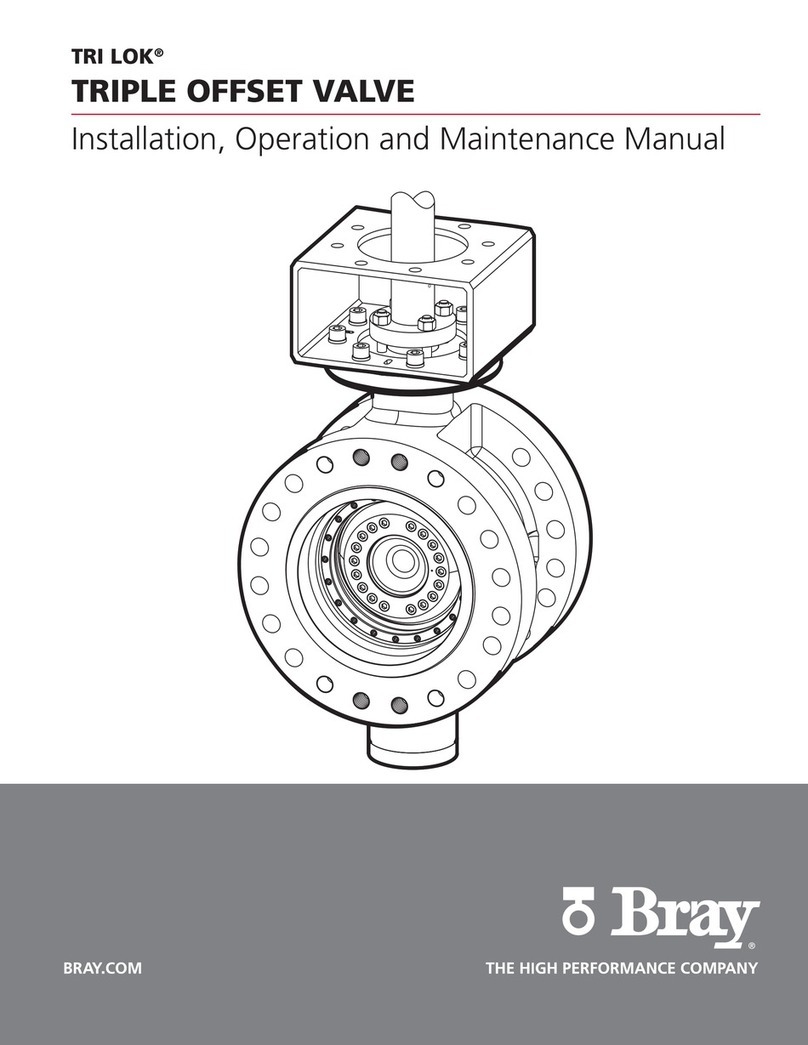
Bray
Bray TRI LOK User manual
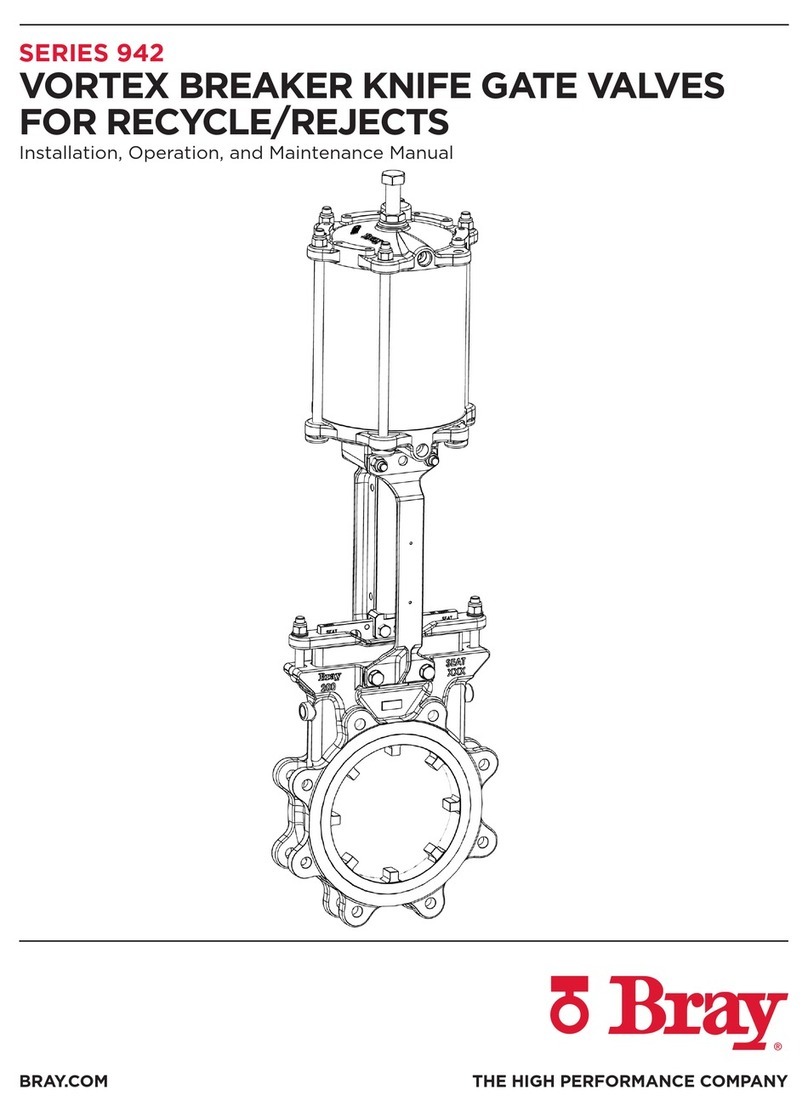
Bray
Bray 942 Series User manual
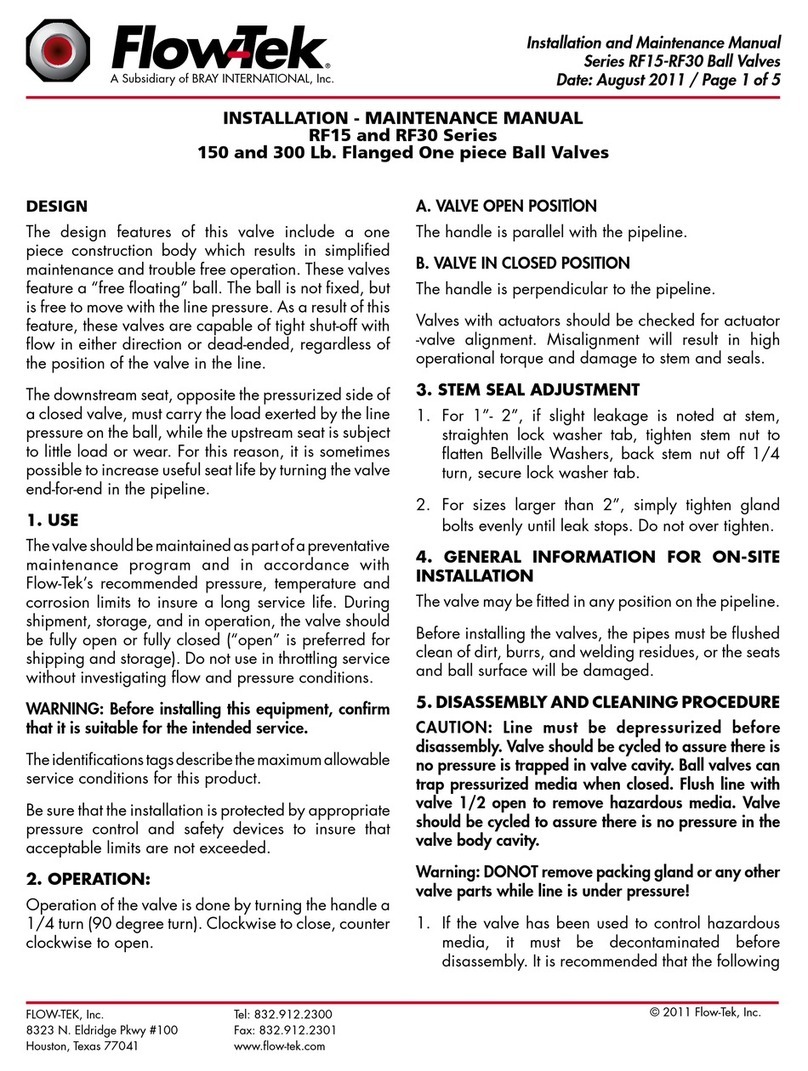
Bray
Bray RF15 Manual

Bray
Bray TRI LOK User manual
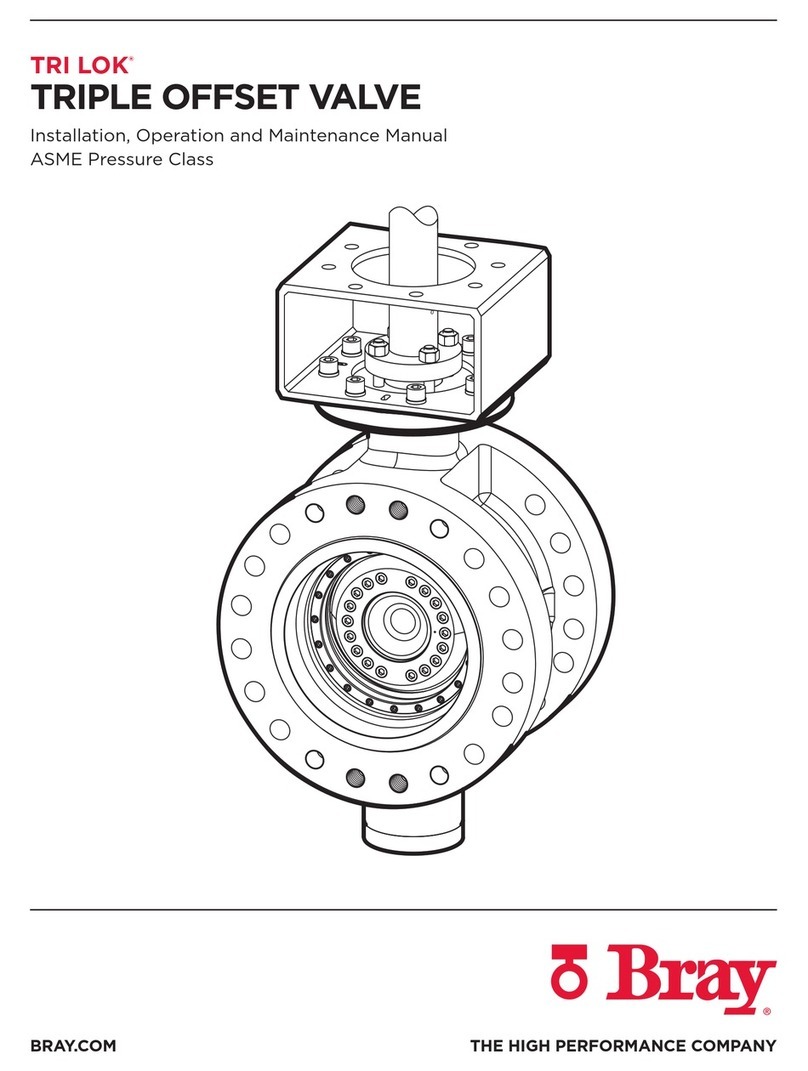
Bray
Bray TRI LOK Series User manual

Bray
Bray 63-N4 Series Instruction manual
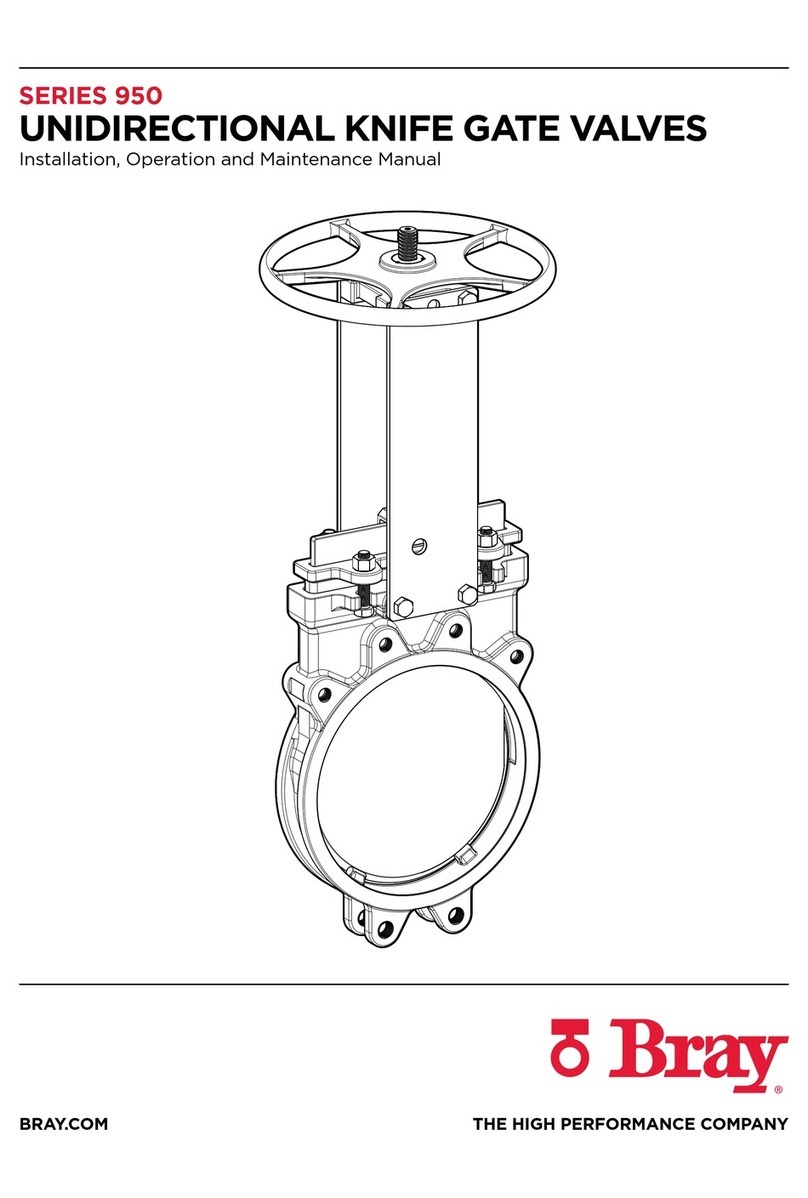
Bray
Bray 950 Series User manual
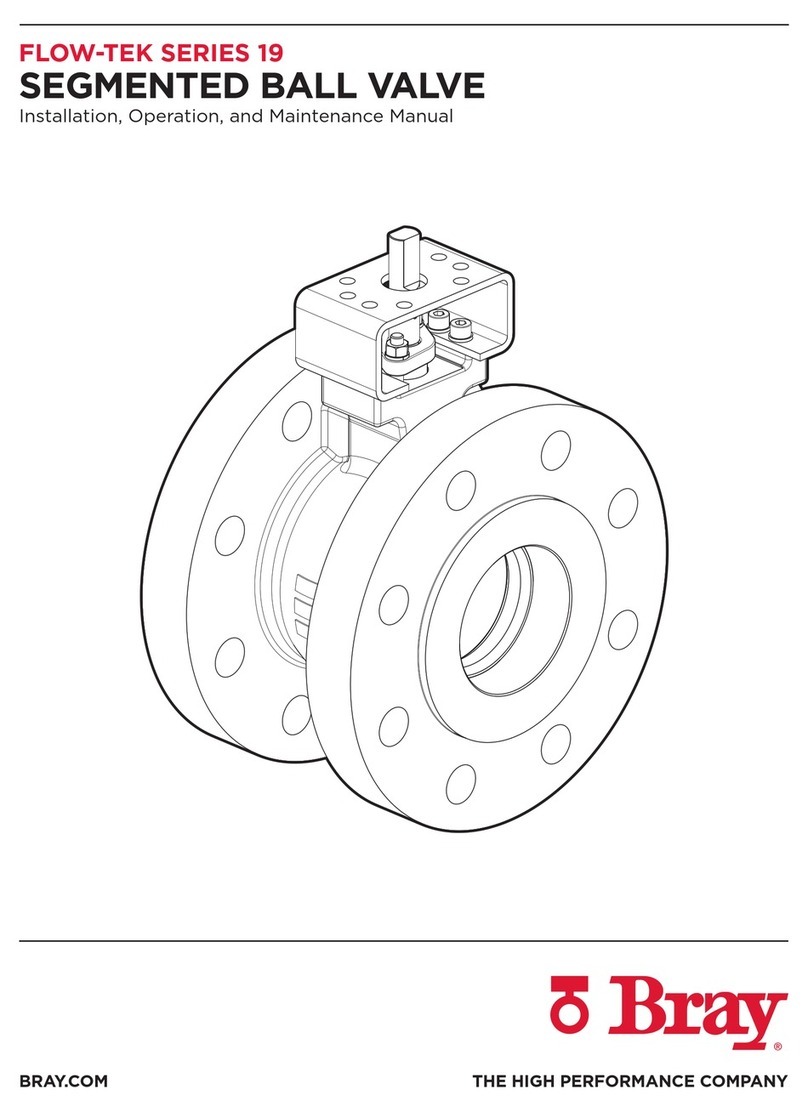
Bray
Bray FLOW-TEK 19 Series User manual

Bray
Bray TRI LOK User manual
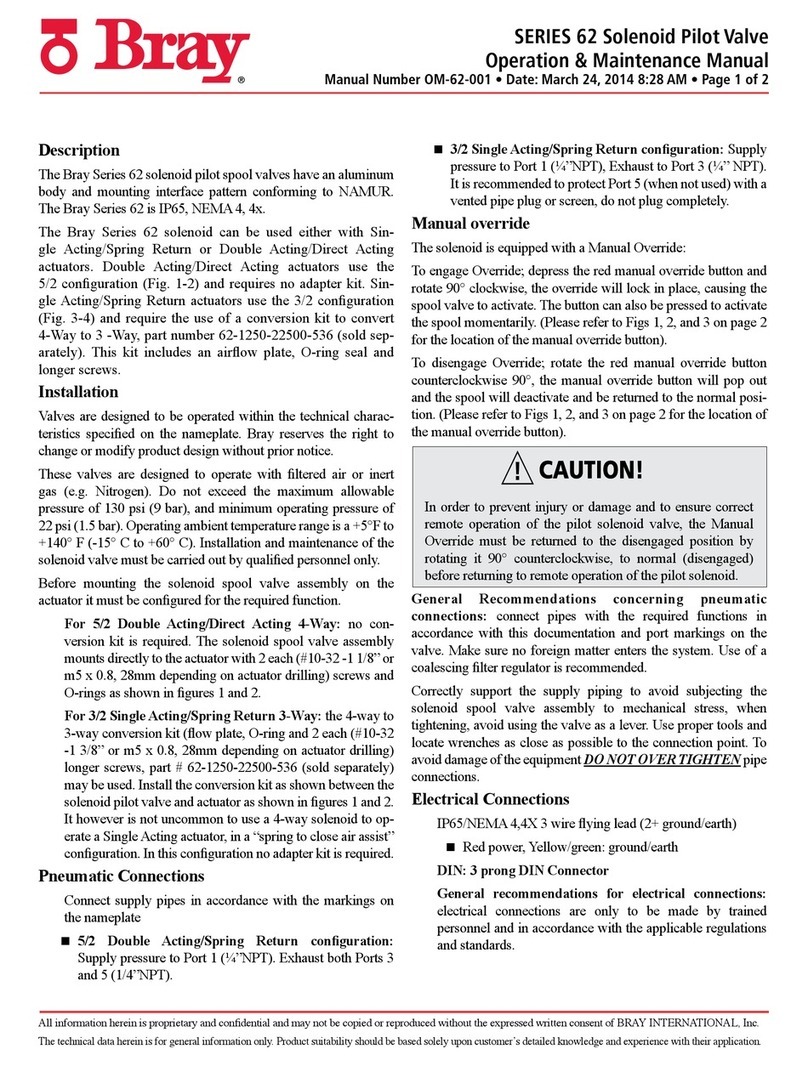
Bray
Bray 62 SERIES Manual
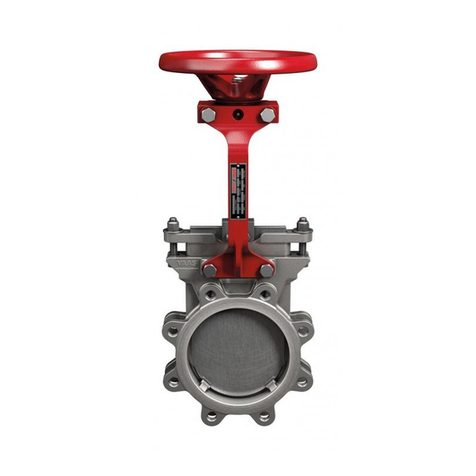
Bray
Bray 940 Series User manual
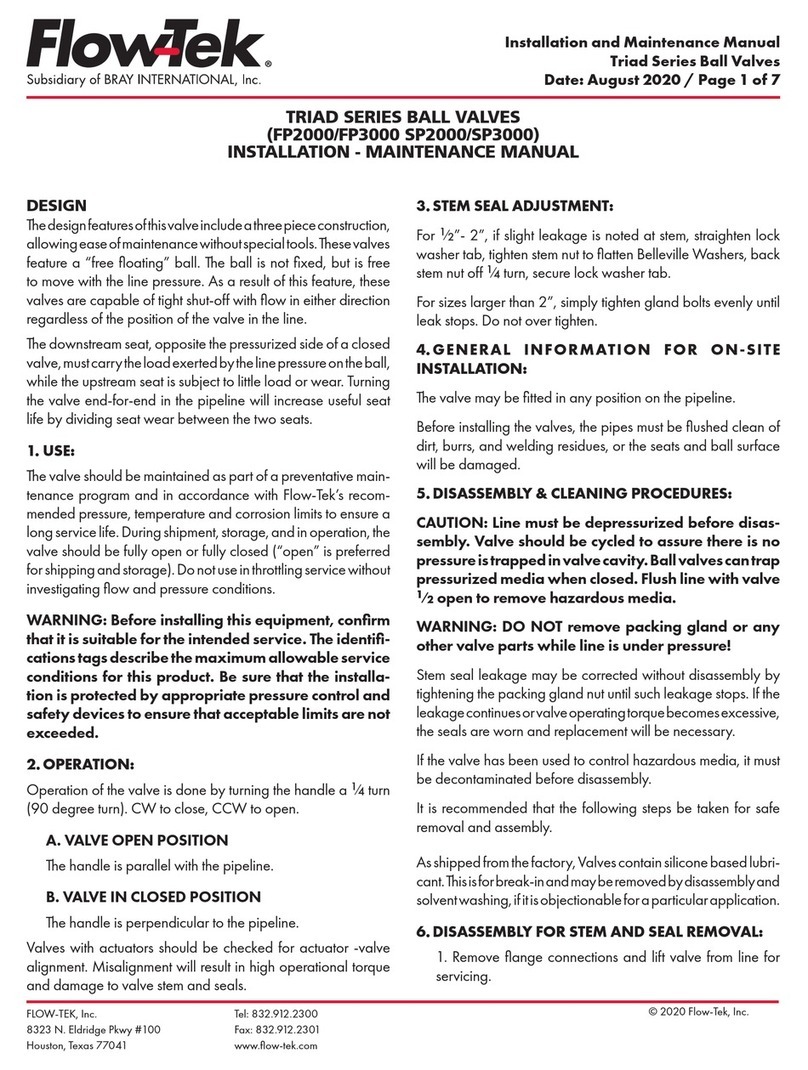
Bray
Bray Flow-Tek Triad Series Instruction Manual
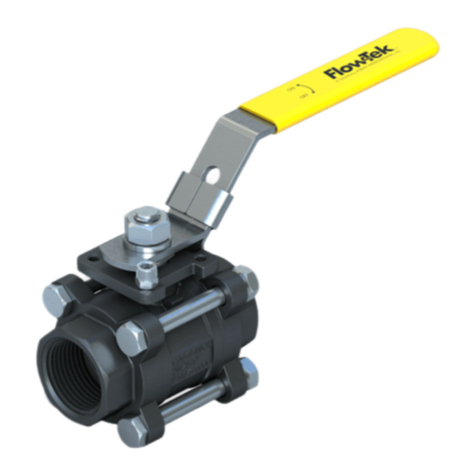
Bray
Bray Flow-Tek 5000 Series User manual
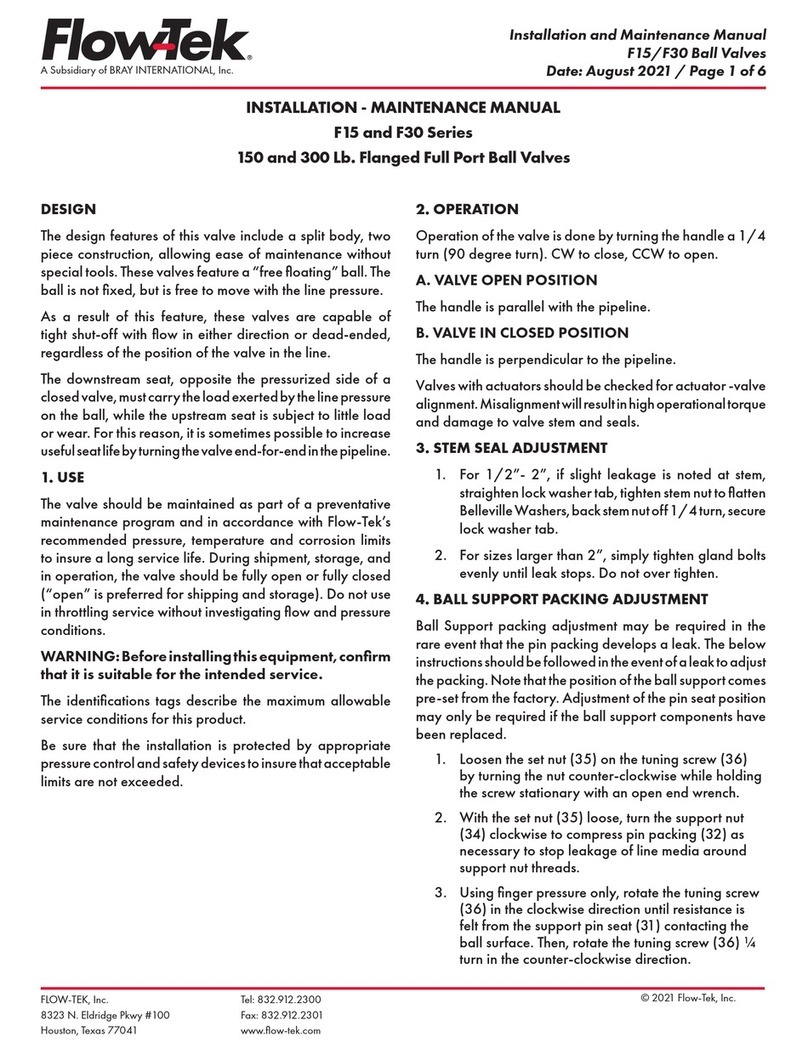
Bray
Bray FlowTek F15 Series Manual
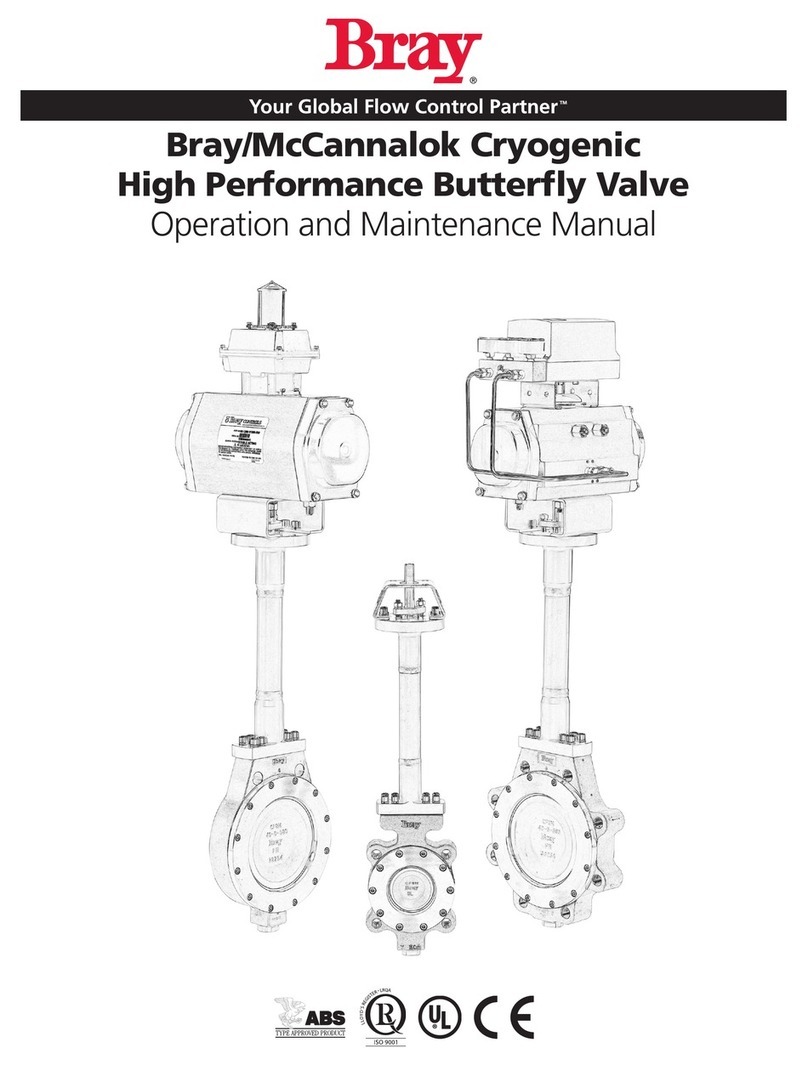
Bray
Bray MCCANNALOK User manual
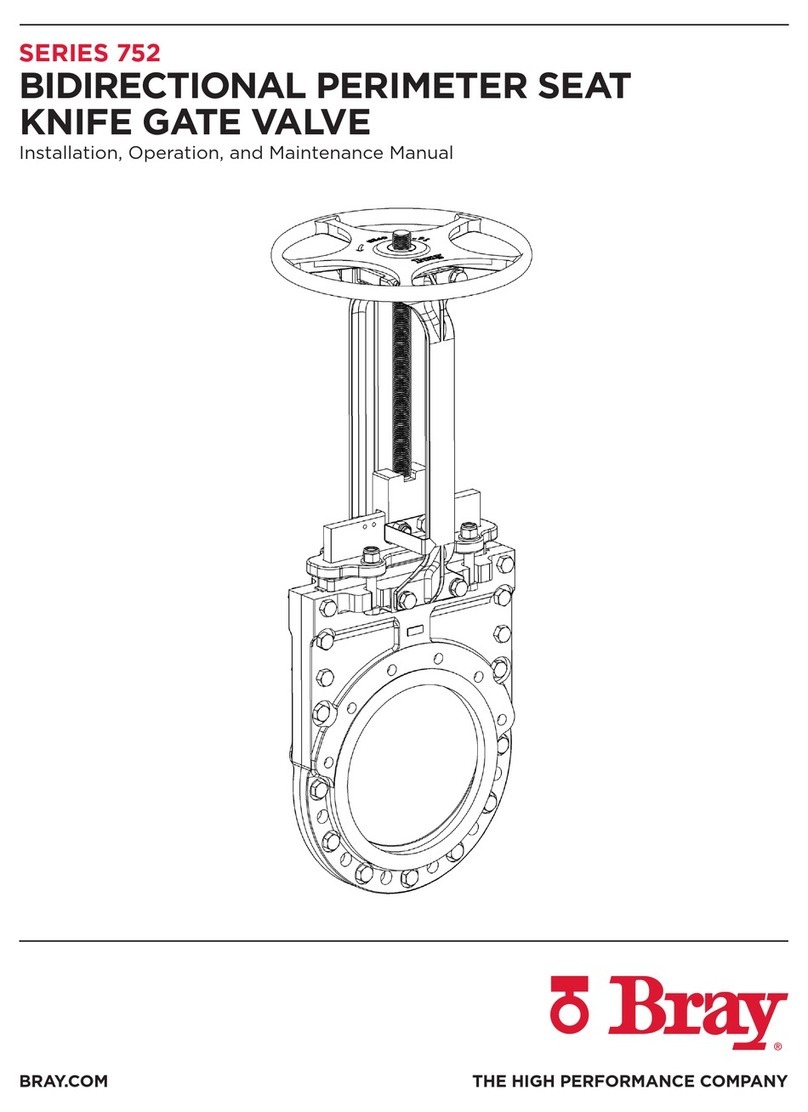
Bray
Bray 752 Series User manual
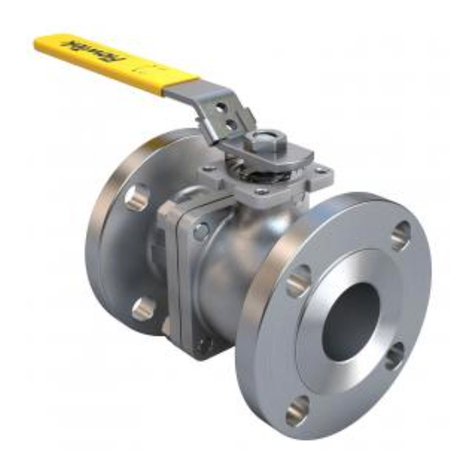
Bray
Bray FlowTek F15 Series User manual
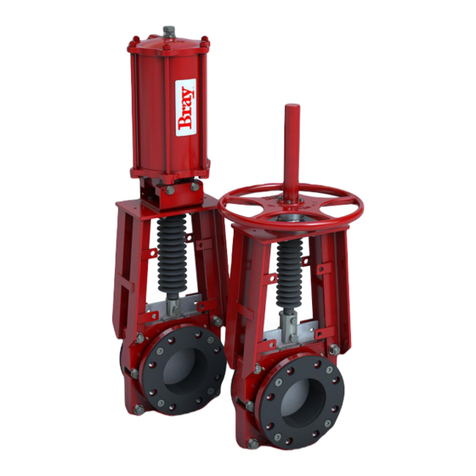
Bray
Bray 762 Series User manual

Bray
Bray TRI LOK Instruction manual
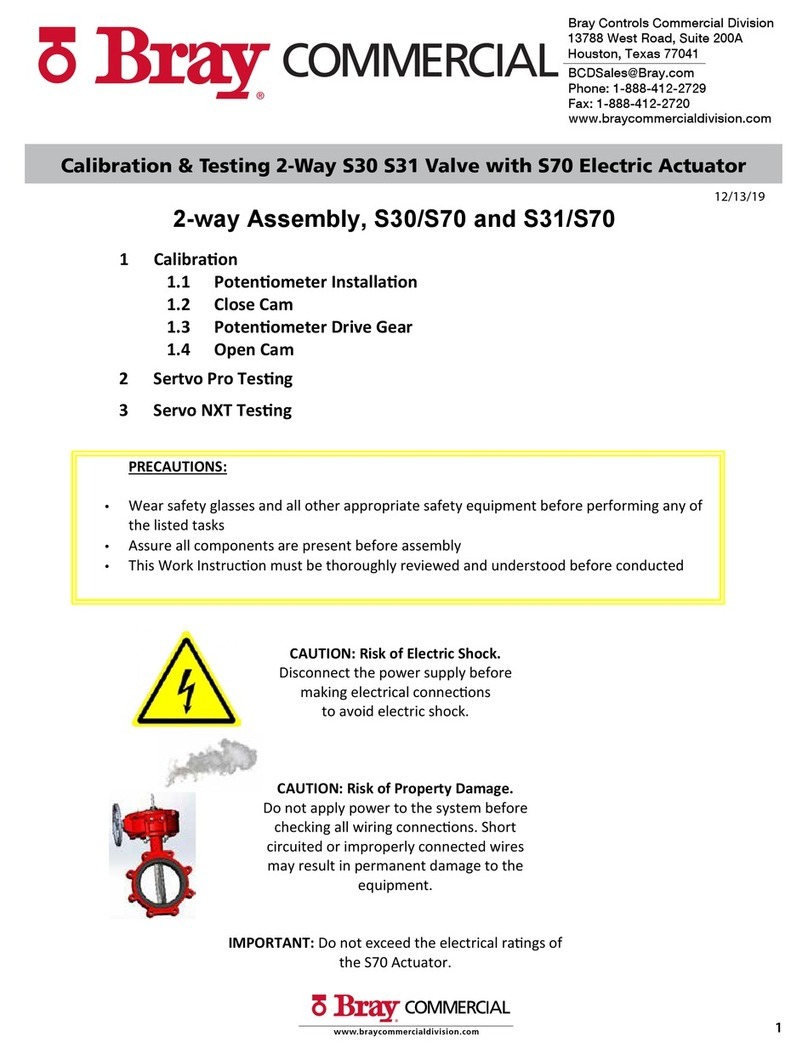
Bray
Bray S30/S70 User manual


